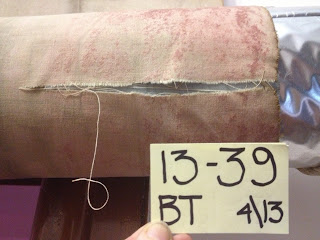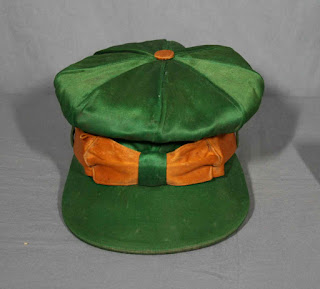At AIC's 2013 annual meeting in Indianapolis, Indiana, I presented a hands-on session on the use of magnets in conservation. Art conservators have been using magnets for many years, but mostly in a very limited way. Perhaps because a system has not been fully understood or described in literature, perhaps because it is not part of our training, or perhaps because it is a practice that is too new to be embraced. This session's purpose was to change all that and give conservators hands-on experience with my favorite things - MAGNETS!!!
 |
| Parts of the jig. |
 |
| The jig put together. |
The focus of the session was for participants to learn and understand the parts of a magnet system so that they may use this knowledge in their own practice. Each part of the magnet system works in tandem in order to achieve the best combination for the artifact. The three parts are:
- The strength of the magnet
- The ferromagnetic material
- The gap or space between the two
These three parts, in various combinations, were experimented with during the session.
Groups were divided into five puzzles or combinations of magnets and ferromagnetic materials. All of the groups were given the same materials to use to create various gaps. The jig works like so: weight is added to the system and then recorded when the system fails. (we are focusing on sheer strength of the magnetic system).
The goal of the session is to become acquainted with the diverse variables of a magnet system. A range of magnets of both Neodymium and ferrite flexible magnets were selected. The ferromagnetic material is also a range that includes several thicknesses of steel plate and preparations of iron powder.
Below is a table that describes the various tests. The Neodymium magnet for all cases were disc, grade N42 and 1/8" thick in a range of diameters. The poles were axially oriented.
Several of these tests have been described in couple conservation publications. They were included for participants to see how not only how they worked, but more importantly, how they could be altered for another situation.
Each group recorded their findings using a real-time internet-based document. Then at the end of the session we discussed the findings. Click here for the final summary of results.
Time will tell, but I am sure once anyone has seen first-hand the power of magnets and can appreciate the ways in which they can be used, they will be as big a fan as I am. On a side note, if you want to see the use of magnets in a conservation project, be sure to check out the most recent edition of the AIC Journal which features a paper from yours truly demonstrating the use of magnets in an upholstery project with a Hunzinger chair.
Special thanks to SmallCorp, Inc who generously made all of the jigs and components for the session. This session was only made possible because of them. My very deep gratitude goes to everyone there for being so helpful and supportive in making this session a reality.
_____________________________
Gwen Spicer is a textile conservator in private practice. Spicer Art Conservation specializes in textile conservation, object conservation, and the conservation of works on paper. Gwen's innovative treatment and mounting of flags and textiles is unrivaled. Her current research focuses on rare earth magnets and their use in conservation. To contact her, please visit her website.
Learn more about magnets and their many uses in the new publications Magnetic Mounting Systems for Museums and Cultural Institutions. Available for purchase at www.spicerart.com/magnetbook.
Team
|
Receiving side
|
Magnet
|
Green – Local
|
Fender washer
Thicker washer
Metallic cups, ½” and
1” in cups
|
½”,
½” in cup,
1”
1” in cup
|
Blue – Iron Powder
|
Iron Powder “Magnetic” paint
- Painted on surface
- Mixed with Epoxy
- Embedded into Batting
|
½”,
½” in cup,
1”
1” in cup
|
Orange – Steel gauge
|
.001,
.025 (24 ga),
½” in cup
|
¼”,
½”,
½” in cup,
|
Red – Flexible magnets
|
Foil tape (.001)
.01
Steel (24 ga)
Flexible magnet (0.06)
|
Flexible magnet (0.03)
(0.06)
(0.125)
|
Yellow - Velcro alternative idea
|
“Slat” Side
Steel (24 ga)
3/4” dia attached to aluminum
Empty cups
|
Removable Side
• Webbing sleeve with pockets for magnets ½”
• Steel (24 ga), powder-coated
• 2 webbing sleeves
|
Several of these tests have been described in couple conservation publications. They were included for participants to see how not only how they worked, but more importantly, how they could be altered for another situation.
Each group recorded their findings using a real-time internet-based document. Then at the end of the session we discussed the findings. Click here for the final summary of results.
Time will tell, but I am sure once anyone has seen first-hand the power of magnets and can appreciate the ways in which they can be used, they will be as big a fan as I am. On a side note, if you want to see the use of magnets in a conservation project, be sure to check out the most recent edition of the AIC Journal which features a paper from yours truly demonstrating the use of magnets in an upholstery project with a Hunzinger chair.
Special thanks to SmallCorp, Inc who generously made all of the jigs and components for the session. This session was only made possible because of them. My very deep gratitude goes to everyone there for being so helpful and supportive in making this session a reality.
_____________________________
Gwen Spicer is a textile conservator in private practice. Spicer Art Conservation specializes in textile conservation, object conservation, and the conservation of works on paper. Gwen's innovative treatment and mounting of flags and textiles is unrivaled. Her current research focuses on rare earth magnets and their use in conservation. To contact her, please visit her website.
Learn more about magnets and their many uses in the new publications Magnetic Mounting Systems for Museums and Cultural Institutions. Available for purchase at www.spicerart.com/magnetbook.












+Harness+BT+3.jpg)







